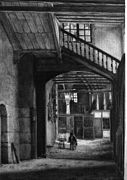Draft:Palais de Justice, Reims
The content of this article is translated from the existing French Wikipedia article at fr:Palais de justice de Reims; see its history for attribution.
| Palais de Justice, Reims | |
|---|---|
 Palais de justice de Reims | |
 | |
| General information | |
| Town or city | Reims |
| Country | France |
| Coordinates | 49°15′15″N 4°01′54″E / 49.2543°N 4.0317°E |
| Design and construction | |
| Architect(s) | Narcisse Brunette |
| Reference no. | PA00078791 |
Location
[edit]The courthouse is situated between Place du Cardinal-Luçon and Place Myron-Herrick in the city center; it is served by tram lines A and B as well as bus lines 1, 2, 3, 4, 5, 6, 8, 9, 16, 30, 40, and Citybus of the Grand Reims Mobilités network.
Functions
[edit]Reims hosts a labor court, a judicial court (which combines the former district and high courts since January 1, 2020), and a Court of Appeal. The judicial court and the commercial court are located here. Consular justice began to be administered in the building replacing the Hôtel-Dieu in 1839.
History
[edit]-
Its facade on the square by Domenico Quaglio the Younger.
-
One hall and
-
another in the 19th century,
-
floor plan, north on the left and the cathedral at the top right,
-
fireplace plaque.
With the establishment of the bishopric in the early 6th century, a building was needed to accommodate travelers, the poor, and the sick. The Hôtel-Dieu was endowed by many bishops of Reims, with the two large halls for the sick attributed to Hincmar. The cathedral chapter managed it, delegating clergy and nuns to run it. Eventually, only nuns of the Order of Saint Augustine served there.
In 1374, there were two sections:
- Men’s section: seven halls, Saint-Jean (31 beds), Cosme (10 beds), Thomas (32 beds), Nicolas (11 beds), Augustin (22 beds), Remy (24 beds), Paul (18 beds); Women’s section: six halls Sainte-Monique (21 beds), Elizabeth (30 beds), Balsamie (24 beds), Marguerite (20 beds), Catherine (24 beds), Félicité (11 beds). And a nursery for abandoned children.
In 1750, the staff consisted of twenty-seven nuns, two clergymen, two chapel guards, eighteen workers and servants, twenty-five maids, two doctors, a surgeon, a receiver, a secretary, a clerk, a chanter, and an organist.
In 1789, the income of the Hôtel-Dieu was 175,000 livres. It had its own chapel dedicated to Saint Nicolas.
In the 19th century, in May 1810, two external and two internal posts were created within the establishment[1]. The care rooms were no longer suitable, leading to the relocation of the Hôtel-Dieu. The General Hospital moved first to the Jesuit College of Reims, then to the Saint-Remi Abbey in 1826. The institution had a significant collection of furnishings, tapestries, and paintings, some of which are now in local museum collections or owned by the current hospital.
Monument Classification
[edit]-
The underground hall,
-
details
-
Column from the classified hall
-
Its heritage.e
-
at the city museum
-
of Reim
The New Building
[edit]Architect Auguste Caristie designed the project to modify the building of the former Hôtel-Dieu with municipal architect Nicolas Serrurier. The works were executed by architect Narcisse Brunette, who designed the neo-Greek style facade. However, the building retained a Louis XV style facade and the Gothic cellars of the Hôtel-Dieu[2]. In 1906, a Detention center from 1835 had to be demolished for expansion works near Reims Cathedral. The new walls were built at the city's edge.
The building was demolished to construct the current courthouse, retaining only the underground hall similar to that of the Palais du Tau, which was classified in 1930.
On the entrance facade, facing Place Myron-Herrick, the pediment features a bas-relief created by Riondet and De Maghellen in 1846, depicting Justice holding a sword and scales. A statue by sculptor Jean-Baptiste Farochon, created in 1852, is located under the portico and represents Integrity[3].
Images
[edit]-
Street facade,
-
The facade on Place Luçon,
-
in detail,
-
prison facade and scrap market,
-
The Hôtel-Dieu, drawing by Maquart in 1845.
Appendices
[edit]Related Articles
[edit]Bibliography
[edit]- Prosper Tarbé, Reims essais historiques sur ses rues & monuments, Res Comédit, 1994 reprint, p. 315.
Références
[edit]- ^ Marie-Thérèse Thiry et Pierre Vilmart, De l'école à la Faculté de médecine de Reims, de l'Hôtel-Dieu au C.H.U. de Reims, L'école de Sages-Femmes de Reims, l'Art de l'accouchement, manuscript, BM Reims RBG 1124, p4, 2011.
- ^ "En direct avec l'histoire de Reims, Place Myron Herrick" (PDF). le site mars-reims(document PDF).
- ^ https://www.audrr.fr/sites/default/files/2019-12/Livre%202%20Equipement%20VF%20web_medium.pdf
External Links
[edit]- Commercial Court website
- http://www.justice.gouv.fr/recherche-juridictions/mapjurid.php?cour=reims Court of Appeal of Reims on the Ministry of Justice website
- ^ Base Mérimée: Ancien hôtel-dieu, Ministère français de la Culture. (in French)
















